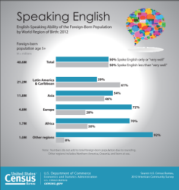Close to Half of New Immigrants Report High English-Language Speaking Ability, Census Bureau Reports
For Immediate Release: Tuesday, June 10, 2014
Close to Half of New Immigrants Report High English-Language Speaking Ability, Census Bureau Reports
In 2012, 44 percent of the foreign-born population age 5 and older who arrived in the United States in 2000 or later reported high English-language speaking ability, according to a U.S. Census Bureau report released today. This means they either reported speaking only English at home or reported speaking it "very well" whether or not they did so at home.
About 13 percent did not speak English at all. By comparison, 63 percent of immigrants who arrived prior to 1980 had high English-speaking ability in 2012, while only 6 percent did not speak English at all.
A new report, English-Speaking Ability of the Foreign-Born Population in the United States: 2012, uses statistics from the Census Bureau's American Community Survey to focus on the relationships between English-speaking ability and place of birth, level of education and years spent living in the United States.
"In general, people who migrated to the United States a long time ago speak English better today than those who migrated recently, and those with more education have higher English-speaking ability than those with less education," said demographer Christine Gambino of the Census Bureau's Foreign-Born Population Branch, one of the report's authors. "This association between time in the United States and educational attainment is seen whether immigrants are from Africa, Asia, Europe and Latin America or the Caribbean."
Almost three-fourths (73 percent) of the foreign-born age 25 and over with a bachelor's degree or higher had high English-speaking ability, speaking only English at home or speaking another language at home and speaking English "very well." The same was true for only 19 percent who had less than a high school education.
The English-speaking ability of the foreign-born does vary geographically. The proportion of foreign-born age 5 and older speaking a language other than English at home was higher in California, Illinois, Nebraska, Nevada, New Mexico, and Texas, at about nine in 10, compared with 85 percent nationally. Furthermore, in all of these states except Nevada, a majority of the foreign-born spoke English less than "very well" (that is, "well," "not well," or "not at all"). For example, 59 percent of the foreign-born in Texas and 57 percent in California spoke English less than "very well," compared with 50 percent nationwide.
Other highlights:
- Among the nearly 41 million foreign-born 5 and older residing in the United States, 15 percent spoke only English at home. More than one-third (35 percent) spoke a non-English language at home and also spoke English "very well," resulting in about half of the foreign-born having high English-speaking ability.
- Over time, the foreign-born have become more likely to speak a language other than English at home, with this percentage rising from 70 percent in 1980 (among those 5 and older) to 79 percent in 1990, 83 percent in 2000 and 85 percent in 2012.
- New Hampshire and the District of Columbia had among the lowest proportions who spoke English less than "very well" (both about 30 percent) among states or equivalents with a foreign-born population age 5 and older of 50,000 or more.
- The foreign-born age 5 and over from Canada, Germany, Jamaica and the United Kingdom were comprised almost entirely of those with high English-speaking ability. Furthermore, the majority of those from India and the Philippines, where English is widely used as an official language, had high English-speaking ability (74 percent and 70 percent, respectively).
- More than half of the foreign-born age 5 and over from Mexico, China, El Salvador, Vietnam, Cuba and Korea spoke English less than "very well." Each of these countries contributed at least 1 million foreign-born residents.
About the American Community Survey
The American Community Survey provides a wide range of important statistics about all communities in the country. The American Community Survey gives communities the current information they need to plan investments and services. Retailers, homebuilders, police departments, and town and city planners are among the many private- and public-sector decision makers who count on these annual results.
Ever since Thomas Jefferson directed the first census in 1790, the census has collected detailed characteristics about our nation's people. Questions about jobs and the economy were added 20 years later under James Madison, who said [PDF - 3.9 MB] such information would allow Congress to "adapt the public measures to the particular circumstances of the community," and over the decades allow America "an opportunity of marking the progress of the society."
Respondents who do not speak English may answer the American Community Survey in several ways. First, by proxy: there may be someone in the household who speaks English and can answer for or serve as an interpreter for those in the household who do not. Second, the survey may be mailed to the household in Spanish. Third, a Census Bureau field representative may arrange for an interviewer or interpreter who speaks the respondent's language to contact the home by phone or in person and assist them in completing the form.
-X-







